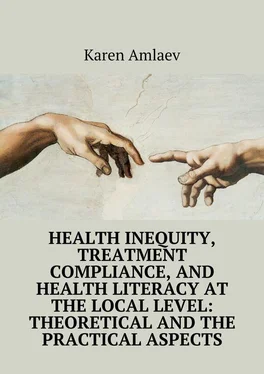Karen Amlaev - Health inequity, treatment compliance, and health literacy at the local level - theoretical and practical aspects
Здесь есть возможность читать онлайн «Karen Amlaev - Health inequity, treatment compliance, and health literacy at the local level - theoretical and practical aspects» — ознакомительный отрывок электронной книги совершенно бесплатно, а после прочтения отрывка купить полную версию. В некоторых случаях можно слушать аудио, скачать через торрент в формате fb2 и присутствует краткое содержание. ISBN: , Жанр: sociology_book, Детская образовательная литература, foreign_language, Прочая научная литература, на английском языке. Описание произведения, (предисловие) а так же отзывы посетителей доступны на портале библиотеки ЛибКат.
- Название:Health inequity, treatment compliance, and health literacy at the local level: theoretical and practical aspects
- Автор:
- Жанр:
- Год:неизвестен
- ISBN:978-5-4474-2118-2
- Рейтинг книги:4 / 5. Голосов: 1
-
Избранное:Добавить в избранное
- Отзывы:
-
Ваша оценка:
- 80
- 1
- 2
- 3
- 4
- 5
Health inequity, treatment compliance, and health literacy at the local level: theoretical and practical aspects: краткое содержание, описание и аннотация
Предлагаем к чтению аннотацию, описание, краткое содержание или предисловие (зависит от того, что написал сам автор книги «Health inequity, treatment compliance, and health literacy at the local level: theoretical and practical aspects»). Если вы не нашли необходимую информацию о книге — напишите в комментариях, мы постараемся отыскать её.
Health inequity, treatment compliance, and health literacy at the local level: theoretical and practical aspects — читать онлайн ознакомительный отрывок
Ниже представлен текст книги, разбитый по страницам. Система сохранения места последней прочитанной страницы, позволяет с удобством читать онлайн бесплатно книгу «Health inequity, treatment compliance, and health literacy at the local level: theoretical and practical aspects», без необходимости каждый раз заново искать на чём Вы остановились. Поставьте закладку, и сможете в любой момент перейти на страницу, на которой закончили чтение.
Интервал:
Закладка:
Males also have some specific features contributing to the development of health inequities. For instance, men’s mental health is significantly due to the position they have in the society.
It is interesting to note though that the relation between men’s mental health and the key markers of their social position – education and financial welfare – is inverse. While a high level of prosperity has a positive effect on men’s mental well-being, their mental health clearly deteriorates along with their education level.
As for women, their realized welfare is largely determined by behavioral factors, mental issues faced in the family environment, and the capacity of their psychological resources allowing them to cope with stress (Expert Group Meeting, United Nations, Division for the Advancement of Women (DAW), World Health Organization (WHO), United Nations Population Fund (UNFPA), Tunisia, 1998).
A number of research projects carried out in Western Europe stress the importance of family in shaping a certain level of health inequity. The parents” resources alone already have an impact on young children’s life quality and create inequity between children from prosperous and poor families. First, the parents” economic capacity determines where and how the family will live. There is a difference if children live in a small rented apartment located in a disadvantaged urban area or in a large house with a garden in a fashionable neighborhood (Meulemann, 1990). Empirical findings show that different life quality among children from poor and prosperous families does not just matter in itself yet it also serves precondition for further inequities. The level of recognition that children enjoy among their friends depends on their toys, sport gear, pets, fashionable clothes, opportunity to travel, pocket money, the configuration of their own computer (Szydlik, M., 2004).
At the same time already in the earliest childhood the parents” resources set important milestones for the entire biography and for the position in the social inequity structure. The parents” choice of the residential area has a direct impact on their children’s first friends” social position. Peers, in turn, have a significant impact on children’s and adolescents” secondary socialization – they either increase or suppress the interest in education and culture. This means that parents, be that deliberately or not, through the social groups of their children’s first friends set the framework for the common and desired standards in education, about which their children learn from their closest environment. Of course, it is also important that the residence determines the choice of school and the level of education in the child’s school friends.
The parents” impact on their children’s education can hardly be overestimated. Education determines the opportunities in life. The individual education has a decisive influence on income, choice of profession, prestige, career, employment opportunities, working conditions, match between the professional background and employment, property, retirement benefit, choice of partner, health and life expectancy. This is why education is a central measure for social stratification. The one with the best education shall get the highest score in all the above-mentioned areas. Each year of school or professional training adds around 6 % to the salary. Better educated people will have less trouble finding an employment and they are fired more seldom. Those with a University degree stand a better chance to find an employment within their area of training (Szydlik М., 1996).
Parents set important educational standards for their children. This is not only about the decisions concerning education itself but also about the general level of education in the family. The very first years of life lay the basis for future academic and professional success. The decisive role here is rather common – the financial capacity of the parents. Therefore, the family connections reproduce social inequity through the entire life. Especially impressive here is the connection of inter-generation solidarity and social inequity. Solidarity between generations is well expressed not only in relation to minor children who still reside with their parents. This goes on after the children leave the parental home. This solidarity continues for the entire life, thus constantly reproducing social inequity.
Parents from higher social groups create better conditions for their children not only in childhood and adolescence. When children become independent they still get support through regular money transfers, gifts, property and, finally, inheritance. This is how the support provided by the upper class to their children through their lives will enforce and even increase the social inequity. The youngster who had better chances due to the parents” resources will have obvious advantage in adulthood.
In general solidarity between generations is well expressed through all the social groups. However, bigger opportunities mean bigger support. Parents without significant resources can never provide such support. This is how families strengthen and increase social inequity. This enhances the chances of children whose parents hold higher social positions thus reducing the opportunities of children from poorer families. Here we must recognize the invaluable service done by the family and assist it in every way. However, an important public and political task is to reduce inequity based on parentage (Szydlik, M., 2004).
Role of education in health inequity
As stressed above, education is one of the major determinants of the economic inequity and its role is increasing year after year.
The public expenses on education make up about 60 % of the total national educational budget; the part covered by the population is about 30 %, with another 10 % coming from the employers. This ratio of public and non-public funding on education (60/40) is significantly different from what economically developed countries have where the population has a higher level of income in general and, which is equally important, where the differentiation in income is much lower, while the private funding from employers and sponsors is higher. For instance, in 2001 in the USA the public budget for education was 69,2 %, in Germany – 81,4 %, in Great Britain – 84,7 %, in Italy – 90,7 %, in Sweden – 96,8 %, in the Czech Republic – 90,6 %, in Slovakia – 97,1 %.
The crisis of public funding for education in Russia stimulates paid education and getting fee from the family for various services, which increases inequity in access to education. Selection is more and more based not on the aptitude criteria but on the applicants” parents” financial capacity. A survey conducted in 2005 by the Russian National Center for Public Opinion showed that half of the Russian population (55 %) cannot afford educational services that are paid, while 21 % of Russians can afford it in extreme cases only. Besides, attending an educational institution and graduating from it with the respective degree certificate does not mean having quality education. The growing density of education both in school and in universities is one of the factors for a certain reduction of its quality. This already contributes, and will contribute on, to the growth of inequity.
However, it is common knowledge that each extra year or education in Russia accounts for a nine-percent death rate reduction in men and a seven-percent death rate reduction in women, while those involved in mental work (especially leaders) demonstrate a higher survival rate than those involved in physical labor (Тапилина В. C., 2004). Researches carried out in St. Petersburg (Russia) showed significant differences in health status esteem depending on the level of education and financial deprivation – in the social groups with limited educational and economic resources the health status was lower (Русинова Н. Л., Браун Дж., 1997; Русинова Н. Л., Панова Л. В., 2003; 2005; Максимова Т. М., 2005; Назарова И. Б, 2007). Foreign authors, too, focused on the issue of social differentiation of health in our country. In order to support the facts mentioned it was shown that the level of financial hardships and education are important predictors of the perceived health (Bobak, Pikhart, Hertzman, Rose and Marmot, 1998; Bobak, Pikhart, Rose, Hertzman, and Michael Marmot, 2000; Carlson, 2000). These works also stated that one of the significant health status determinants is such an indicator of social well-being as the perceived control over the life circumstances.
Читать дальшеИнтервал:
Закладка:
Похожие книги на «Health inequity, treatment compliance, and health literacy at the local level: theoretical and practical aspects»
Представляем Вашему вниманию похожие книги на «Health inequity, treatment compliance, and health literacy at the local level: theoretical and practical aspects» списком для выбора. Мы отобрали схожую по названию и смыслу литературу в надежде предоставить читателям больше вариантов отыскать новые, интересные, ещё непрочитанные произведения.
Обсуждение, отзывы о книге «Health inequity, treatment compliance, and health literacy at the local level: theoretical and practical aspects» и просто собственные мнения читателей. Оставьте ваши комментарии, напишите, что Вы думаете о произведении, его смысле или главных героях. Укажите что конкретно понравилось, а что нет, и почему Вы так считаете.












